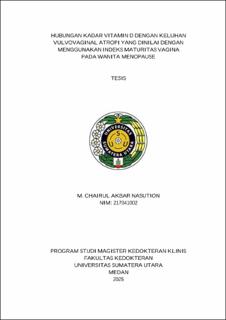Hubungan Kadar Vitamin D Dengan Keluhan Vulvovaginal Atropi Yang Dinilai Dengan Menggunakan Indeks Maturitas Vagina Pada Wanita Menopause
The Relationship Between Vitamin D Level On Vulvovaginal Atrophy Symptomps Evaluated Using Vaginal Maturation Index In Menopausal Woman

Date
2025Author
Nasution, Muhammad Chairul Akbar
Advisor(s)
Siregar, Muhammad Fidel Ganis
Barus, Melvin Nova Gunawanto
Metadata
Show full item recordAbstract
Background: Vulvovaginal atrophy (VVA) is a common complaint among
postmenopausal women due to estrogen deficiency, leading to dryness, irritation,
and discomfort, significantly affecting their quality of life. Recent studies suggest
that Vitamin D may play a role in maintaining vaginal epithelial integrity and
immune function, but its relationship with VVA remains underexplored.
Objective: This study aims to investigate the relationship between serum Vitamin
D levels and vulvovaginal atrophy, assessed using the Vaginal Maturity Index
(VMI), in postmenopausal women. Methods: This was an observational
analytical study with a cross-sectional design conducted at the University of
Sumatera Utara Hospital. A total of 32 postmenopausal women were enrolled.
Data collection included demographic characteristics, serum Vitamin D levels,
and VMI assessment. Statistical analysis was performed using the Spearman
correlation test. Results: The mean Vitamin D level among participants was 19.5
± 5.6 ng/mL, indicating a deficiency. The mean VMI score was 59.16 ± 8.99. A
significant positive correlation was found between serum Vitamin D levels and
VMI scores (r = 0.610, p = 0.001), suggesting that higher Vitamin D levels were
associated with better vaginal epithelial maturity. Conclusion: There is a strong
correlation between Vitamin D levels and VMI in postmenopausal women. These
findings suggest that Vitamin D may play a role in maintaining vaginal health and
could be considered in managing VVA symptoms. Further research is needed to
explore Vitamin D supplementation as a potential therapeutic strategy for VVA in
postmenopausal women.
